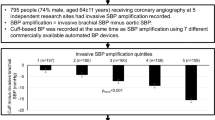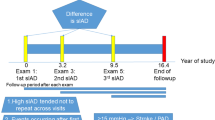Abstract
Central systolic blood pressure (SBP) may differ between individuals with similar brachial SBP, which may have implications for risk assessment. This study aimed to determine the variation and potential clinical value of central SBP between patients with similar brachial SBP. Brachial SBP was measured by sphygmomanometer and central SBP by radial tonometry in 675 people (430 men), comprising healthy individuals (n=222), patients with known or suspected coronary artery disease (n=229) and diabetes (n=224). Individuals were stratified by brachial SBP in accordance with European Society of Hypertension guidelines (optimal, normal, high-normal, grades 1, 2 and 3 hypertension). The potential clinical value of central SBP was determined from the percentage of patients re-classified into different brachial SBP groups due to the difference between brachial and aortic SBP (defined as brachial SBP–central SBP). Central SBP increased with each brachial SBP level (optimal to grade 3 hypertension; P<0.001 for all). However, large variation in brachial–aortic SBP difference occurred within each brachial SBP group (range 2–33 mm Hg), resulting in sizeable overlap of central SBP between brachial SBP groups. For patients with normal brachial SBP, 96% had central SBP within the range of patients with high-normal brachial SBP, as well as 64% within the range of patients with grade 1 hypertension. We conclude that wide variation in brachial–aortic SBP difference occurs between patients with similar brachial SBP. This results in a significant overlap of central SBP scores between brachial SBP risk groups. This is likely to have treatment implications but remains to be tested.
This is a preview of subscription content, access via your institution
Access options
Subscribe to this journal
Receive 12 digital issues and online access to articles
$119.00 per year
only $9.92 per issue
Buy this article
- Purchase on Springer Link
- Instant access to full article PDF
Prices may be subject to local taxes which are calculated during checkout



Similar content being viewed by others
References
European Society of Hypertension-European Society of Cardiology guidelines for the management of arterial hypertension. J Hypertens 2003; 21: 1011–1053.
Chobanian AV, Bakris GL, Black HR, Cushman WC, Green LA, Izzo Jr JL et al. The seventh report of the Joint National Committee on prevention, detection, evaluation, and treatment of high blood pressure: the JNC 7 report. JAMA 2003; 289: 2560–2572.
McEniery CM, Yasmin, Hall IR, Qasem A, Wilkinson IB, Cockcroft JR . Normal vascular aging: differential effects on wave reflection and aortic pulse wave velocity: the Anglo-Cardiff Collaborative Trial (ACCT). J Am Coll Cardiol 2005; 46: 1753–1760.
Wilkinson IB, Prasad K, Hall IR, Thomas A, MacCallum H, Webb DJ et al. Increased central pulse pressure and augmentation index in subjects with hypercholesterolemia. J Am Coll Cardiol 2002; 39: 1005–1011.
Vlachopoulos C, Kosmopoulou F, Panagiotakos D, Ioakeimidis N, Alexopoulos N, Pitsavos C et al. Smoking and caffeine have a synergistic detrimental effect on aortic stiffness and wave reflections. J Am Coll Cardiol 2004; 44: 1911–1917.
Wilkinson IB, MacCallum H, Hupperetz PC, van Thoor CJ, Cockcroft JR, Webb DJ . Changes in the derived central pressure waveform and pulse pressure in response to angiotensin II and noradrenaline in man. J Physiol 2001; 530: 541–550.
Wilkinson IB, Mohammad NH, Tyrrell S, Hall IR, Webb DJ, Paul VE et al. Heart rate dependency of pulse pressure amplification and arterial stiffness. Am J Hypertens 2002; 15: 24–30.
Sharman JE, McEniery CM, Campbell R, Coombes JS, Wilkinson IB, Cockcroft JR . The effect of exercise on large artery hemodynamics in healthy young men. Eur J Clin Invest 2005; 35: 738–744.
Kroeker EJ, Wood EH . Comparison of simultaneously recorded central and peripheral arterial pressure pulses during rest, exercise and tilted position in man. Circ Res 1955; 3: 623–632.
Lewington S, Clarke R, Qizilbash N, Peto R, Collins R . Age-specific relevance of usual blood pressure to vascular mortality: a meta-analysis of individual data for one million adults in 61 prospective studies. Lancet 2002; 360: 1903–1913.
Williams B, Lacy PS, Thom SM, Cruickshank K, Stanton A, Collier D et al. Differential impact of blood pressure-lowering drugs on central aortic pressure and clinical outcomes: principal results of the Conduit Artery Function Evaluation (CAFE) study. Circulation 2006; 113: 1213–1225.
Safar ME, Blacher J, Pannier B, Guerin AP, Marchais SJ, Guyonvarc′h PM et al. Central pulse pressure and mortality in end-stage renal disease. Hypertension 2002; 39: 735–738.
London GM, Blacher J, Pannier B, Guerin AP, Marchais SJ, Safar ME . Arterial wave reflections and survival in end-stage renal failure. Hypertension 2001; 38: 434–438.
Roman MJ, Devereux RB, Kizer JR, Lee ET, Galloway JM, Ali T et al. Central pressure more strongly relates to vascular disease and outcome than does brachial pressure: the Strong Heart Study. Hypertension 2007; 50: 197–203.
Chirinos JA, Zambrano JP, Chakko S, Veerani A, Schob A, Perez G et al. Aortic pressure augmentation predicts adverse cardiovascular events in patients with established coronary artery disease. Am J Hypertens 2005; 18: A11–A12.
Ueda H, Hayashi T, Tsumura K, Yoshimaru K, Nakayama Y, Yoshikawa J . The timing of the reflected wave in the ascending aortic pressure predicts restenosis after coronary stent placement. Hypertens Res 2004; 27: 535–540.
Laurent S, Cockcroft J, Van Bortel L, Boutouyrie P, Giannattasio C, Hayoz D et al. Expert consensus document on arterial stiffness: methodological issues and clinical applications. Eur Heart J 2006; 27: 2588–2605.
Chen CH, Nevo E, Fetics B, Pak PH, Yin FC, Maughan WL et al. Estimation of central aortic pressure waveform by mathematical transformation of radial tonometry pressure. Validation of generalized transfer function. Circulation 1997; 95: 1827–1836.
Sharman JE, Lim R, Qasem AM, Coombes JS, Burgess MI, Franco J et al. Validation of a generalized transfer function to noninvasively derive central blood pressure during exercise. Hypertension 2006; 47: 1203–1208.
Wilkinson IB, Fuchs SA, Jansen IM, Spratt JC, Murray GD, Cockcroft JR et al. Reproducibility of pulse wave velocity and augmentation index measured by pulse wave analysis. J Hypertens 1998; 16: 2079–2084.
McEniery CM, Yasmin, McDonnell B, Munnery M, Wallace SM, Rowe CV et al. Central pressure: variability and impact of cardiovascular risk factors. The Anglo-Cardiff Collaborative Trial II. Hypertension 2008; 51(6): 1476–1482.
Lekakis JP, Zakopoulos NA, Protogerou AD, Kotsis VT, Papaioannou TG, Stamatelopoulos KS et al. Cardiac hypertrophy in hypertension: relation to 24-h blood pressure profile and arterial stiffness. Int J Cardiol 2004; 97: 29–33.
Nakamura M, Sato K, Nagano M . Estimation of aortic systolic blood pressure in community-based screening: the relationship between clinical characteristics and peripheral to central blood pressure differences. J Hum Hypertens 2005; 19: 251–253.
Saba PS, Roman MJ, Pini R, Spitzer M, Ganau A, Devereux RB . Relation of arterial pressure waveform to left ventricular and carotid anatomy in normotensive subjects. J Am Coll Cardiol 1993; 22: 1873–1880.
Marchais SJ, Guerin AP, Pannier BM, Levy BI, Safar ME, London GM . Wave reflections and cardiac hypertrophy in chronic uremia. Influence of body size. Hypertension 1993; 22: 876–883.
Sharman JE, Fang ZY, Haluska B, Stowasser M, Prins JB, Marwick TH . Left ventricular mass in patients with type 2 diabetes mellitus is independently associated with central but not peripheral pulse pressure. Diabetes Care 2005; 28: 937–939.
Hashimoto J, Imai Y, O'Rourke MF . Indices of pulse wave analysis are better predictors of left ventricular mass reduction than cuff pressure. Am J Hypertens 2007; 20: 378–384.
O′Rourke MF, Vlachopoulos C, Graham RM . Spurious systolic hypertension in youth. Vasc Med 2000; 5: 141–145.
Mahmud A, Feely J . Spurious systolic hypertension of youth: fit young men with elastic arteries. Am J Hypertens 2003; 16: 229–232.
Hulsen HT, Nijdam ME, Bos WJ, Uiterwaal CS, Oren A, Grobbee DE et al. Spurious systolic hypertension in young adults; prevalence of high brachial systolic blood pressure and low central pressure and its determinants. J Hypertens 2006; 24: 1027–1032.
Krzesinski JM, Saint-Remy A . Spurious systolic hypertension in youth: what does it really mean in clinical practice? J Hypertens 2006; 24: 999–1001.
Acknowledgements
This study was supported in part by a Centre for Clinical Research Excellence award, National Health and Medical Research Council (NHMRC), Canberra, Australia. Dr Sharman was supported by a NHRMC Australian Clinical Research Fellowship (reference 409940).
Author information
Authors and Affiliations
Corresponding author
Rights and permissions
About this article
Cite this article
Sharman, J., Stowasser, M., Fassett, R. et al. Central blood pressure measurement may improve risk stratification. J Hum Hypertens 22, 838–844 (2008). https://doi.org/10.1038/jhh.2008.71
Received:
Revised:
Accepted:
Published:
Issue Date:
DOI: https://doi.org/10.1038/jhh.2008.71
Keywords
This article is cited by
-
Comparison of the usefulness of the cardio-ankle vascular index and augmentation index as an index of arteriosclerosis in patients with essential hypertension
Hypertension Research (2022)
-
Features and implications of higher systolic central than peripheral blood pressure in patients at very high risk of atherosclerotic cardiovascular disease
Journal of Human Hypertension (2021)
-
Central-to-brachial blood pressure amplification in type 2 diabetes: a systematic review and meta-analysis
Journal of Human Hypertension (2019)
-
CardioFAN: open source platform for noninvasive assessment of pulse transit time and pulsatile flow in hyperelastic vascular networks
Biomechanics and Modeling in Mechanobiology (2019)
-
Validity of the augmentation index and pulse pressure amplification as determined by the SphygmoCor XCEL device: a comparison with invasive measurements
Hypertension Research (2018)



